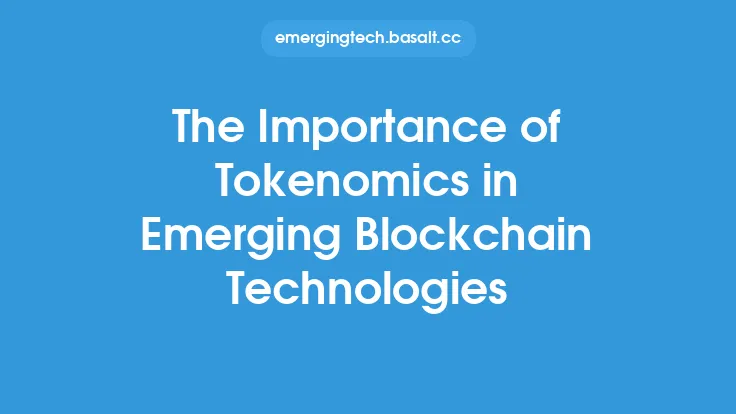The concept of tokenomics has become a crucial aspect of blockchain ecosystems, as it plays a vital role in determining the overall health and stability of a blockchain network. Tokenomics refers to the study of the economics and design of tokens, which are the native assets of a blockchain network. It involves analyzing the supply and demand dynamics of tokens, as well as the incentives and mechanisms that drive their creation, distribution, and usage. In this article, we will delve into the role of tokenomics in blockchain ecosystems and explore its significance in maintaining a robust and sustainable blockchain network.
Introduction to Tokenomics
Tokenomics is a multidisciplinary field that combines economics, game theory, and computer science to design and analyze token-based systems. It involves understanding the behavior of tokens and their interactions with users, developers, and other stakeholders within a blockchain ecosystem. Tokenomics is essential for creating a well-functioning token economy, which is critical for the success of a blockchain project. A well-designed token economy can incentivize users to participate in the network, contribute to its growth, and maintain its stability.
Key Components of Tokenomics
There are several key components of tokenomics that are essential for creating a healthy token economy. These include token supply, token demand, token velocity, and token distribution. Token supply refers to the total amount of tokens available in the market, while token demand refers to the desire of users to hold or use tokens. Token velocity measures the rate at which tokens are spent or transferred within the network, and token distribution refers to the way tokens are allocated among users, developers, and other stakeholders. Understanding these components is crucial for designing a token economy that is balanced, sustainable, and aligned with the goals of the blockchain project.
Tokenomics and Blockchain Governance
Tokenomics plays a critical role in blockchain governance, as it influences the decision-making processes and incentives of stakeholders within the network. A well-designed token economy can align the interests of users, developers, and other stakeholders, ensuring that the network is maintained and upgraded in a way that benefits all parties. Tokenomics can also be used to create incentives for users to participate in governance processes, such as voting on proposals or validating transactions. By designing a token economy that rewards participation and contribution, blockchain projects can create a more decentralized and community-driven governance model.
Tokenomics and Network Effects
Tokenomics can also have a significant impact on network effects, which refer to the benefits that users derive from interacting with a large and active community. A well-designed token economy can create incentives for users to join and participate in the network, which can lead to a self-reinforcing cycle of growth and adoption. As more users join the network, the value of the token increases, which in turn attracts more users and creates a positive feedback loop. Tokenomics can be used to amplify network effects by creating incentives for users to invite others to join the network, contribute to its growth, and maintain its stability.
Best Practices for Tokenomics
Designing a successful token economy requires a deep understanding of tokenomics and its applications. Some best practices for tokenomics include creating a clear and transparent token model, designing incentives that align with the goals of the blockchain project, and implementing mechanisms for token governance and decision-making. It is also essential to conduct thorough research and analysis to understand the behavior of users and the dynamics of the token economy. By following these best practices, blockchain projects can create a well-functioning token economy that supports the growth and adoption of the network.
Common Challenges in Tokenomics
Despite its importance, tokenomics is not without its challenges. One of the most significant challenges is designing a token economy that is balanced and sustainable in the long term. This requires a deep understanding of the dynamics of the token economy and the behavior of users. Another challenge is creating incentives that align with the goals of the blockchain project, while also ensuring that the token economy is resilient to external shocks and market volatility. Additionally, tokenomics must be designed to comply with regulatory requirements and ensure that the token economy is fair and transparent.
Conclusion
In conclusion, tokenomics plays a vital role in blockchain ecosystems, as it determines the overall health and stability of a blockchain network. By understanding the key components of tokenomics, including token supply, token demand, token velocity, and token distribution, blockchain projects can create a well-functioning token economy that supports the growth and adoption of the network. Tokenomics is also critical for blockchain governance, as it influences the decision-making processes and incentives of stakeholders within the network. By following best practices and addressing common challenges, blockchain projects can create a successful token economy that supports the long-term sustainability and success of the network.





